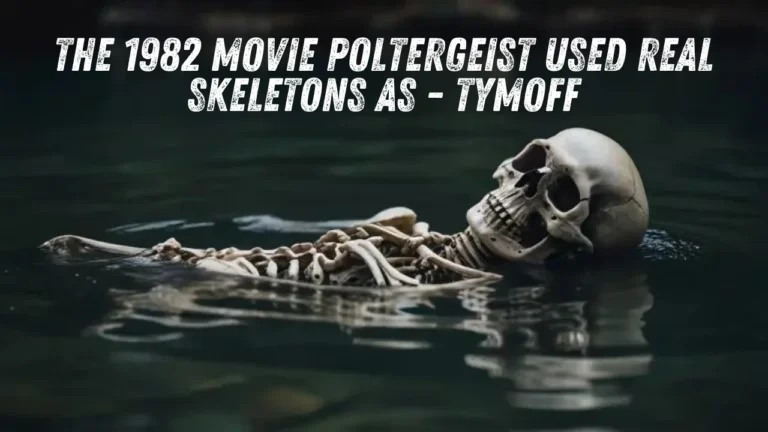Introduction
The 1982 movie Poltergeist, directed by Tobe Hooper and produced by Steven Spielberg, is often celebrated as a cornerstone of horror cinema. With its chilling narrative and groundbreaking special effects, it tells the haunting story of a family besieged by malevolent spirits in their suburban home. However, one aspect of the film has overshadowed its acclaim: the shocking revelation that The 1982 Movie Poltergeist Used Real Skeletons as – Tymoff. This decision not only raised ethical questions but also contributed to the film’s legacy as a cultural phenomenon. In this article, we will explore the implications of this revelation, the reactions from cast and crew, and the lasting impact on the horror genre.
The Making of Poltergeist
A Horror Classic in the Making
Before delving into the skeleton controversy, it’s crucial to understand the context of Poltergeist. The film follows the Freeling family, whose idyllic life is shattered when they discover their home is haunted. As the supernatural events intensify, they seek help from paranormal experts to rescue their daughter, Carol Anne, from the clutches of the spirits.
With a talented cast, including JoBeth Williams, Craig T. Nelson, and young Heather O’Rourke, Poltergeist became a box office hit, grossing over $76 million in the U.S. alone. The film was lauded for its innovative special effects, achieved through the expertise of Industrial Light & Magic (ILM). However, the decision to use real skeletons during production has become a focal point of discussion among fans and critics alike.
The Shocking Revelation
Behind the Decision
The revelation that The 1982 Movie Poltergeist Used Real Skeletons as – Tymoff emerged years after the film’s release. During one of the film’s pivotal scenes, characters confront a swimming pool filled with skeletons, a striking visual that heightened the horror. Initially, the production team planned to use prop skeletons, which are typically made of plastic or rubber. However, due to budget constraints and time limitations, they opted for real human skeletons sourced from medical supply companies.
Ethical Implications
The use of real skeletons brings forth significant ethical concerns. The decision was kept largely under wraps until after the film’s release, leading to shock and outrage among cast and crew members. JoBeth Williams, who played Diane Freeling, expressed disbelief upon learning the truth. Many have since debated whether the filmmakers crossed a line by utilizing human remains for cinematic purposes. While some argue the decision contributed to the film’s authenticity, others see it as a blatant disregard for the dignity of the deceased.
The Impact on the Cast and Crew
Psychological Effects
The revelation that the The 1982 Movie Poltergeist Used Real Skeletons as – Tymoff had a profound psychological effect on many involved in the production. Some cast members reported feeling haunted by the experience, leading to speculation about a so-called “Poltergeist curse.” This notion gained traction after several cast members faced untimely deaths, including young Heather O’Rourke, who tragically passed away in 1988. Such incidents have only fueled the eerie reputation surrounding the film.
Reflections from the Cast
In various interviews, cast members have shared their thoughts on the use of real skeletons. Williams has stated that, although she was horrified, she understood the filmmakers’ intention to create a visceral experience. She emphasized that Poltergeist reflected the era’s willingness to push boundaries in filmmaking, often at the cost of ethical considerations.
The Legacy of Poltergeist
Cultural Impact
Despite the controversy, The 1982 Movie Poltergeist Used Real Skeletons as – Tymoff remains a significant work in horror cinema. Its influence can be seen in numerous films and TV shows that explore themes of hauntings and the supernatural. The phrase “They’re here!” has become iconic, embedding itself in popular culture and inspiring generations of filmmakers and audiences.
Technological Advancements
The practical effects and innovative techniques employed in Poltergeist have set a standard for future horror films. The film’s combination of animatronics, puppetry, and special effects pioneered new ways of creating believable supernatural elements. This legacy can be seen in modern horror films that strive for a blend of realism and fantasy.
Also Read: Why JoinPD.com is the Go-To Platform for Educator Growth
Conclusion
The revelation that The 1982 Movie Poltergeist Used Real Skeletons as – Tymoff adds a haunting layer to its already complex narrative. This decision raises important ethical questions about the treatment of human remains in art and the responsibilities filmmakers have toward their subjects. While the controversy surrounding the use of real skeletons has sparked debates, it also enriches the film’s legacy, reminding us of the thin line between creativity and respect for human life. As we continue to explore the depths of Poltergeist, we must also reflect on the moral considerations that come with creating art that ventures into the realm of the supernatural.


